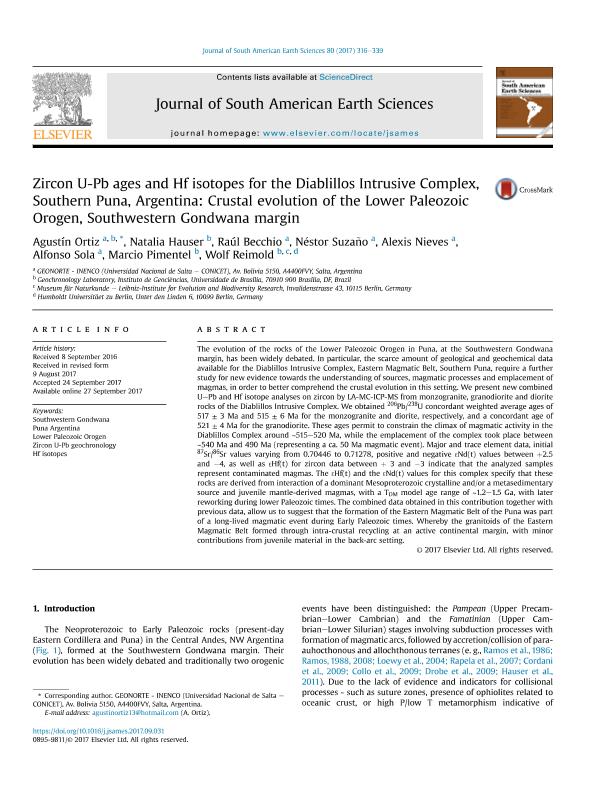Mostrar el registro sencillo del ítem
dc.contributor.author
Ortiz Yañez, Agustín

dc.contributor.author
Hauser, Natalia

dc.contributor.author
Becchio, Raul Alberto

dc.contributor.author
Suzaño, Nestor Omar

dc.contributor.author
Nieves, Alexis Iván Angel

dc.contributor.author
Sola, Alfonso Manuel

dc.contributor.author
Pimentel, Marcio
dc.contributor.author
Reimold, Wolf
dc.date.available
2018-04-09T20:10:00Z
dc.date.issued
2017-12
dc.identifier.citation
Ortiz Yañez, Agustín; Hauser, Natalia; Becchio, Raul Alberto; Suzaño, Nestor Omar; Nieves, Alexis Iván Angel; et al.; Zircon U-Pb ages and Hf isotopes for the Diablillos Intrusive Complex, Southern Puna, Argentina: Crustal evolution of the Lower Paleozoic Orogen, Southwestern Gondwana margin; Pergamon-Elsevier Science Ltd; Journal of South American Earth Sciences; 80; 12-2017; 316-339
dc.identifier.issn
0895-9811
dc.identifier.uri
http://hdl.handle.net/11336/41417
dc.description.abstract
The evolution of the rocks of the Lower Paleozoic Orogen in Puna, at the Southwestern Gondwana margin, has been widely debated. In particular, the scarce amount of geological and geochemical data available for the Diablillos Intrusive Complex, Eastern Magmatic Belt, Southern Puna, require a further study for new evidence towards the understanding of sources, magmatic processes and ofmagmas, in order to better comprehend the crustal evolution in this setting. We present new combined UePb and Hf isotope analyses on zircon by LA-MC-ICP-MS from monzogranite, granodiorite and diorite rocks of the Diablillos Intrusive Complex. We obtained 206Pb/238U concordant weighted average ages of 517 ± 3 Ma and 515 ± 6 Ma for the monzogranite and diorite, respectively, and a concordant age of 521 ± 4 Ma for the granodiorite. These ages permit to constrain the climax of magmatic activity in the Diablillos Complex around ~515e520 Ma, while the emplacement of the complex took place between ~540 Ma and 490 Ma (representing a ca. 50 Ma magmatic event). Major and trace element data, initial87Sr/86Sr values varying from 0.70446 to 0.71278, positive and negative 3Nd(t) values between þ2.5 and 4, as well as 3Hf(t) for zircon data between þ 3 and 3 indicate that the analyzed samples represent contaminated magmas. The 3Hf(t) and the 3Nd(t) values for this complex specify that these rocks are derived from interaction of a dominant Mesoproterozoic crystalline and/or a metasedimentarysource and juvenile mantle-derived magmas, with a TDM model age range of ~1.2e1.5 Ga, with later reworking during lower Paleozoic times. The combined data obtained in this contribution together with previous data, allow us to suggest that the formation of the Eastern Magmatic Belt of the Puna was partof a long-lived magmatic event during Early Paleozoic times. Whereby the granitoids of the Eastern Magmatic Belt formed through intra-crustal recycling at an active continental margin, with minor contributions from juvenile material in the back-arc setting.
dc.format
application/pdf
dc.language.iso
eng
dc.publisher
Pergamon-Elsevier Science Ltd

dc.rights
info:eu-repo/semantics/openAccess
dc.rights.uri
https://creativecommons.org/licenses/by-nc-nd/2.5/ar/
dc.subject
Southwestern Gondwana
dc.subject
Puna Argentina
dc.subject
Lower Paleozoic Orogen
dc.subject
Zircon U-Pb Geochronology
dc.subject.classification
Meteorología y Ciencias Atmosféricas

dc.subject.classification
Ciencias de la Tierra y relacionadas con el Medio Ambiente

dc.subject.classification
CIENCIAS NATURALES Y EXACTAS

dc.title
Zircon U-Pb ages and Hf isotopes for the Diablillos Intrusive Complex, Southern Puna, Argentina: Crustal evolution of the Lower Paleozoic Orogen, Southwestern Gondwana margin
dc.type
info:eu-repo/semantics/article
dc.type
info:ar-repo/semantics/artículo
dc.type
info:eu-repo/semantics/publishedVersion
dc.date.updated
2018-04-09T15:04:39Z
dc.journal.volume
80
dc.journal.pagination
316-339
dc.journal.pais
Estados Unidos

dc.description.fil
Fil: Ortiz Yañez, Agustín. Consejo Nacional de Investigaciones Científicas y Técnicas. Centro Científico Tecnológico Conicet - Salta. Instituto de Investigaciones en Energía no Convencional. Universidad Nacional de Salta. Facultad de Ciencias Exactas. Departamento de Física. Instituto de Investigaciones en Energía no Convencional; Argentina. Universidade do Brasília; Brasil
dc.description.fil
Fil: Hauser, Natalia. Universidade do Brasília; Brasil. Consejo Nacional de Investigaciones Científicas y Técnicas; Argentina
dc.description.fil
Fil: Becchio, Raul Alberto. Consejo Nacional de Investigaciones Científicas y Técnicas. Centro Científico Tecnológico Conicet - Salta. Instituto de Investigaciones en Energía no Convencional. Universidad Nacional de Salta. Facultad de Ciencias Exactas. Departamento de Física. Instituto de Investigaciones en Energía no Convencional; Argentina
dc.description.fil
Fil: Suzaño, Nestor Omar. Consejo Nacional de Investigaciones Científicas y Técnicas. Centro Científico Tecnológico Conicet - Salta. Instituto de Investigaciones en Energía no Convencional. Universidad Nacional de Salta. Facultad de Ciencias Exactas. Departamento de Física. Instituto de Investigaciones en Energía no Convencional; Argentina
dc.description.fil
Fil: Nieves, Alexis Iván Angel. Consejo Nacional de Investigaciones Científicas y Técnicas. Centro Científico Tecnológico Conicet - Salta. Instituto de Investigaciones en Energía no Convencional. Universidad Nacional de Salta. Facultad de Ciencias Exactas. Departamento de Física. Instituto de Investigaciones en Energía no Convencional; Argentina
dc.description.fil
Fil: Sola, Alfonso Manuel. Consejo Nacional de Investigaciones Científicas y Técnicas. Centro Científico Tecnológico Conicet - Salta. Instituto de Investigaciones en Energía no Convencional. Universidad Nacional de Salta. Facultad de Ciencias Exactas. Departamento de Física. Instituto de Investigaciones en Energía no Convencional; Argentina
dc.description.fil
Fil: Pimentel, Marcio. Universidade do Brasília; Brasil
dc.description.fil
Fil: Reimold, Wolf. Universidade do Brasília; Brasil. Leibniz-Institute for Evolution and Biodiversity Research; Alemania. Humboldt Universitäet zu Berlin; Alemania
dc.journal.title
Journal of South American Earth Sciences

dc.relation.alternativeid
info:eu-repo/semantics/altIdentifier/doi/http://dx.doi.org/10.1016/j.jsames.2017.09.031
dc.relation.alternativeid
info:eu-repo/semantics/altIdentifier/url/https://www.sciencedirect.com/science/article/pii/S0895981116301705
Archivos asociados
